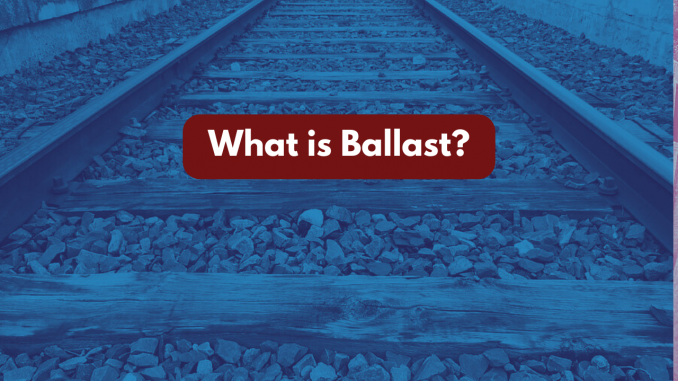
In the world of engineering and construction, certain terms may not be as familiar to the average person as they are to professionals in these fields. One such term is “ballast.” Often overlooked but critically important, ballast plays a significant role in various industries, from railroads to construction. In this blog post, we’ll delve into the world of ballast, exploring what it is, its types, functions, and applications.
What is Ballast?
Ballast is a special blend of products used to provide stability and support to a structure or vehicle. Its primary function is to distribute weight evenly and prevent movement or shifting. While ballast can be found in various forms and applications, its purpose remains consistent: to maintain stability and balance.
Common materials used as ballast include crushed stone, gravel, sand, concrete, and water (in the case of ship ballast). The choice of material depends on the specific application and its requirements for weight distribution and stability.
The different types of Ballast
Ballast materials can vary widely depending on the industry and application. Here are some common types of ballast:
Railroad Ballast
Perhaps the most well-known use of ballast is in railroads. Railroad ballast consists of crushed stone, gravel, or other durable materials placed beneath the railroad tracks. Its purpose is to distribute the weight of the trains and track evenly, provide drainage, and prevent the tracks from sinking into the ground.
Ship Ballast
In the maritime industry, ballast is used to stabilize ships. Ballast water, often taken on in one location and discharged in another, is used to control a ship’s draft and balance. This ensures safe navigation and prevents excessive tilting or listing.
Construction Ballast
In construction, ballast refers to materials like sand, gravel, or concrete that are used to stabilize structures like buildings, bridges, and roadways. It can be used as a foundation layer or added weight to ensure stability during construction and throughout a structure’s life.
Aircraft Ballast
In aviation, ballast is used to balance aircraft. This can include the addition of weights in specific locations to ensure proper weight distribution, particularly in smaller aircraft.
What is Ballast used for?
Now that we understand the types of ballast, let’s explore their key functions:
- Stability: Ballast’s primary function is to provide stability. Whether it’s a train on tracks, a ship at sea, or a building under construction, ballast prevents tipping, tilting, or shifting, ensuring safety and functionality.
- Weight Distribution: Ballast evenly distributes weight, preventing excessive stress on any single point. This is vital for the longevity and performance of structures and vehicles.
- Balance: Ballast helps maintain balance in various applications. For example, in aviation, ballast is crucial for ensuring an aircraft’s center of gravity is within safe limits.
- Preventing Settlement: In construction, ballast can prevent the settling of foundations by providing a stable base that distributes the load evenly over the underlying soil.
Ballast is a simple yet essential element in various industries, playing a vital role in stability, weight distribution, and balance. From railroads to construction sites and ships to aircraft, ballast ensures that structures and vehicles remain safe and operational. Understanding the importance of ballast helps us appreciate the engineering and planning that goes into maintaining stability in the world around us.
How Much Ballast do i need for 1m3 of Concrete?
The amount of ballast (aggregate) you need for 1 cubic meter (m³) of concrete depends on the desired concrete mix ratio. The mix ratio is the proportion of various ingredients, including cement, sand, and aggregate (ballast). Common mix ratios include:
- Nominal Mix Ratio (M20, M25, etc.):
- 1 part cement : 1.5 parts sand : 3 parts aggregate (by volume)
- Standard Mix Ratio (1:2:4):
- 1 part cement : 2 parts sand : 4 parts aggregate (by volume)
- High-Strength Concrete Mix (1:1.5:3):
- 1 part cement : 1.5 parts sand : 3 parts aggregate (by volume)
To calculate the amount of ballast needed, you’ll need to convert the mix ratio to actual volumes. For example, in a 1:2:4 mix ratio for 1 cubic meter of concrete:
- Cement = 1/7 * 1 m³ (approximately)
- Sand = 2/7 * 1 m³ (approximately)
- Aggregate (ballast) = 4/7 * 1 m³ (approximately)
So, in this case, you would need about 0.5714 m³ (4/7 * 1) of ballast for 1 cubic meter of concrete.
It’s essential to note that these are general mix ratios, and the actual amount of ballast can vary based on factors like the moisture content in the aggregate, the specific type of aggregate used, and other factors. Always refer to local building codes and standards for precise requirements.

Leave a Reply